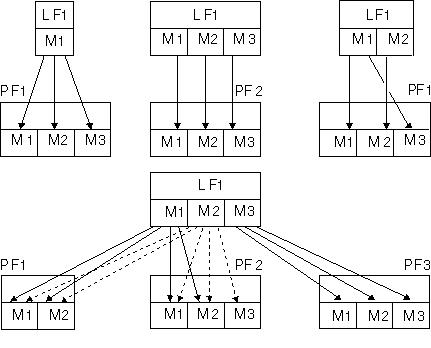You can define members in logical files to separate the data into logical groups. The logical file member can be associated with one or several physical file members.
The following chart illustrates this concept:

The record formats used with all logical members in a logical file must be defined in data description specifications (DDS) when the file is created. If new record formats are needed, another logical file or record format must be created.
The attributes of an access path are determined by the information specified in DDS and on commands when the logical file is created. The selection of data members is specified in the DTAMBRS parameter on the Create Logical File (CRTLF) and Add Logical File Member (ADDLFM) commands.
When a logical file is defined, the physical files used by the logical file are specified in DDS by the record-level PFILE or JFILE keyword. If multiple record formats are defined in DDS, a PFILE keyword must be specified for each record format. You can specify one or more physical files for each PFILE keyword.
When a logical file is created or a member is added to the file, you can use the DTAMBRS parameter on the CRTLF or the ADDLFM command to specify which members of the physical files used by the logical file are to be used for data. *NONE can be specified as the physical file member name if no members from a physical file are to be used for data.
In the following example, the logical file has two record formats defined:
|...+....1....+....2....+....3....+....4....+....5....+....6....+....7....+....8
A
00010A R LOGRCD2 PFILE(PF1 PF2)
A .
A .
A .
00020A R LOGRCD3 PFILE(PF1 PF2 PF3)
A .
A .
A .
A
DTAMBRS((PF1 M1) (PF2 (M1 M2)) (PF1 M1) (PF2 (*NONE)) (PF3 M3))
Record format LOGRCD2 is associated with physical file member M1 in PF1 and M1 and M2 in file PF2. Record format LOGRCD3 is associated with M1 in PF1 and M3 in PF3. No members in PF2 are associated with LOGRCD3. If the same physical file name is specified on more than one PFILE keyword, each occurrence of the physical file name is handled as a different physical file.
If a library name is not specified for the file on the PFILE keyword, the library list is used to find the physical file when the logical file is created. The physical file name and the library name then become part of the logical file description. The physical file names and the library names specified on the DTAMBRS parameter must be the same as those stored in the logical file description.
If a file name is not qualified by a library name on the DTAMBRS parameter, the library name defaults to *CURRENT, and the system uses the library name that is stored in the logical file description for the respective physical file name. This library name is either the library name that was specified for the file on the PFILE DDS keyword or the name of the library in which the file was found using the library list when the logical file was created.
- Specify no associated physical file members (DTAMBRS (*ALL) default). The logical file member is associated with all the physical file members of all physical files in all the PFILE keywords specified in the logical file DDS.
- Specify the associated physical file members (DTAMBRS parameter). If you do not specify library names, the logical file determines the libraries used. When more than one physical file member is specified for a physical file, the member names should be specified in the order in which records are to be retrieved when duplicate key values occur across those members. If you do not want to include any members from a particular physical file, either do not specify the physical file name or specify the physical file name and *NONE for the member name. This method can be used to define a logical file member that contains a subset of the record formats defined for the logical file.
CRTLF FILE(DSTPRODLB/ORDHDRL)
MBR(*FILE) DTAMBRS(*ALL)
TEXT('Order header logical file')
*FILE is the default for the MBR parameter and means that the name of the member is the same as the name of the file. All the members of the associated physical file (ORDHDRP) are used in the logical file (ORDHDRL) member. The text description is the text description of the member.